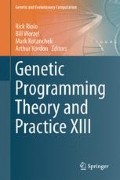Abstract
A data set for classification is commonly composed of a set of features defining the data space representation and one attribute corresponding to the instances’ class. A classification tool has to discover how to separate classes based on features, but the discovery of useful knowledge may be hampered by inadequate or insufficient features. Pre-processing steps for the automatic construction of new high-level features proposed to discover hidden relationships among features and to improve classification quality. Here we present a new tool for high-level feature construction: Kaizen Programming. This tool can construct many complementary/dependent high-level features simultaneously. We show that our approach outperforms related methods on well-known binary-class medical data sets using a decision-tree classifier, achieving greater accuracy and smaller trees.
Access this chapter
Tax calculation will be finalised at checkout
Purchases are for personal use only
Notes
- 1.
Thirty-two runs were performed because it is a multiple of 8, and the runs were done in parallel on a quad-core machine with hyper-threading, so we employed all available processing units.
References
Banzhaf W, Nordin P, Keller R, Francone F (1998) Genetic programming - an introduction. Morgan Kaufmann, San Francisco
Brameier M, Banzhaf W (2001) Evolving teams of predictors with linear genetic programming. Genet Program Evolvable Mach 2(4):381–407
Breiman L (2001) Random forests. Mach Learn 45(1):5–32
Breiman L, Friedman J, Stone C, Olshen R (1984) Classification and regression trees. The Wadsworth and Brooks-Cole statistics-probability series. Taylor & Francis, London
de Melo VV (2014) Kaizen programming. In: Proceedings of the 2014 conference on genetic and evolutionary computation (GECCO). ACM, New York, pp 895–902
Drozdz K, Kwasnicka H (2010) Feature set reduction by evolutionary selection and construction. In: Agent and multi-agent systems: technologies and applications. Springer, Berlin, Heidelberg, pp 140–149
Freitas AA (2008) A review of evolutionary algorithms for data mining. In: Soft computing for knowledge discovery and data mining, Springer, Berlin, pp 79–111
Gavrilis D, Tsoulos IG, Dermatas E (2008) Selecting and constructing features using grammatical evolution. Pattern Recogn Lett 29(9):1358–1365. doi:10.1016/j.patrec.2008.02.007. http://www.sciencedirect.com/science/article/B6V15-4S01WDH-4/2/aaff3c40c5eca125dfacb 426d88fa177
Gitlow H, Gitlow S, Oppenheim A, Oppenheim R (1989) Tools and methods for the improvement of quality. Irwin series in quantitative analysis for business. Taylor & Francis, London
Guo H, Zhang Q, Nandi AK (2008) Feature extraction and dimensionality reduction by genetic programming based on the fisher criterion. Expert Syst 25(5):444–459
Guo PF, Bhattacharya P, Kharma N (2010) Advances in detecting parkinson’s disease. In: Zhang D, Sonka M (eds) Medical biometrics. Lecture notes in computer science, vol 6165. Springer, Berlin, Heidelberg, pp 306–314
Hall M, Frank E, Holmes G, Pfahringer B, Reutemann P, Witten IH (2009) The weka data mining software: an update. SIGKDD Explor Newsl 11(1):10–18. doi:10.1145/1656274.1656278. http://doi.acm.org/10.1145/1656274.1656278
Imai M (1986) Kaizen (Ky’zen), the key to Japan’s competitive success. McGraw-Hill, New York
Isabelle G, André E, An introduction to feature extraction. In: Guyon I, Gunn S, Nikravesh M, Zadeh LA (eds) Feature extraction: foundations and applications (Studies in Fuzziness and Soft Computing). Springer, Berlin/Heidelberg, pp 1–25. doi:10.1007/978-3-540-35488-8
Jolliffe I (2005) Principal component analysis. Wiley Online Library
Kantardzic M (2011) Data mining: concepts, models, methods, and algorithms. Wiley, New York
Lichman M (2013) UCI machine learning repository. http://archive.ics.uci.edu/ml
Liu H, Motoda H (1998) Feature extraction, construction and selection: a data mining perspective. Springer, Berlin
Miner G, Nisbet R, Elder IVJ (2009) Handbook of statistical analysis and data mining applications. Academic Press, New York
Muharram MA, Smith GD (2004) Evolutionary feature construction using information gain and gini index. In: Genetic programming, Springer, pp 379–388
Neshatian K, Zhang M, Johnston M (2007) Feature construction and dimension reduction using genetic programming. In: AI 2007: advances in artificial intelligence. Springer, Berlin, pp 160–170
Neshatian K, Zhang M, Andreae P (2012) A filter approach to multiple feature construction for symbolic learning classifiers using genetic programming. Trans Evol Comp 16(5):645–661
Nguyen DV, Rocke DM (2004) On partial least squares dimension reduction for microarray-based classification: a simulation study. Comput Stat Data Anal 46(3):407–425
Pedregosa F, Varoquaux G, Gramfort A, Michel V, Thirion B, Grisel O, Blondel M, Prettenhofer P, Weiss R, Dubourg V, Vanderplas J, Passos A, Cournapeau D, Brucher M, Perrot M, Duchesnay E (2011) Scikit-learn: machine learning in Python. J Mach Learn Res 12:2825–2830
Schölkopf B, Smola A, Müller KR (1997) Kernel principal component analysis. In: Artificial neural networks–ICANN 97. Springer, Berlin, pp 583–588
Smith MG, Bull L (2005) Genetic programming with a genetic algorithm for feature construction and selection. Genet Program Evolvable Mach 6(3):265–281
Wolpert DH, Macready WG (1997) No free lunch theorems for optimization. IEEE Trans Evol Comput 1(1):67–82
Wu SX, Banzhaf W (2010) A hierarchical cooperative evolutionary algorithm. In: Proceedings of the 12th annual conference on genetic and evolutionary computation, GECCO ’10. ACM, New York, pp 233–240
Wu SX, Banzhaf W (2011) Rethinking multilevel selection in genetic programming. In: Proceedings of the 13th annual conference on genetic and evolutionary computation, Dublin, pp 1403–1410
Acknowledgements
This paper was supported by the Brazilian Government CNPq (Universal) grant (486950/2013-1) and CAPES (Science without Borders) grant (12180-13-0) to Vinícius Veloso de Melo, and Canada’s NSERC Discovery grant RGPIN 283304-2012 to Wolfgang Banzhaf.
Author information
Authors and Affiliations
Corresponding author
Editor information
Editors and Affiliations
Rights and permissions
Copyright information
© 2016 Springer International Publishing Switzerland
About this chapter
Cite this chapter
de Melo, V.V., Banzhaf, W. (2016). Kaizen Programming for Feature Construction for Classification. In: Riolo, R., Worzel, W., Kotanchek, M., Kordon, A. (eds) Genetic Programming Theory and Practice XIII. Genetic and Evolutionary Computation. Springer, Cham. https://doi.org/10.1007/978-3-319-34223-8_3
Download citation
DOI: https://doi.org/10.1007/978-3-319-34223-8_3
Published:
Publisher Name: Springer, Cham
Print ISBN: 978-3-319-34221-4
Online ISBN: 978-3-319-34223-8
eBook Packages: Computer ScienceComputer Science (R0)

